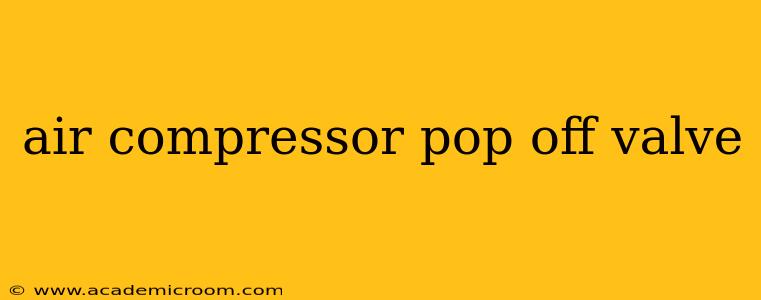Air compressor pop-off valves are crucial safety devices preventing dangerous pressure buildup. Understanding how they work, troubleshooting common issues, and knowing when to replace them is vital for safe and efficient compressor operation. This comprehensive guide will cover everything you need to know about air compressor pop-off valves.
What is an Air Compressor Pop-Off Valve?
An air compressor pop-off valve, also known as a pressure relief valve or safety valve, is a pressure-regulating device designed to automatically release compressed air when the tank pressure exceeds a preset limit. This prevents overpressurization, which could lead to tank rupture and potential injury or property damage. The valve opens when the pressure surpasses the designated threshold, releasing air until the pressure drops to a safe level. It's a critical component for ensuring the safe operation of any air compressor.
How Does an Air Compressor Pop-Off Valve Work?
The mechanism is relatively straightforward. Most pop-off valves utilize a spring-loaded mechanism. A spring resists the pressure within the tank. Once the pressure overcomes the spring's force, the valve opens, allowing compressed air to escape. The spring's tension determines the valve's set pressure. Some advanced models might incorporate more complex mechanisms, but the core function remains the same: to protect the tank and its surroundings from excessive pressure.
What Happens if My Air Compressor Pop-Off Valve Fails?
A malfunctioning pop-off valve is a serious safety concern. If the valve fails to open when pressure exceeds the safe limit, the tank could rupture, resulting in:
- Serious injury: The force of a ruptured tank can cause severe injuries from flying debris and escaping compressed air.
- Property damage: The rupture can damage surrounding equipment and property.
- Compressor damage: Excessive pressure can permanently damage the compressor's internal components.
Regular inspection and maintenance are crucial to prevent such scenarios.
How Often Should I Test My Air Compressor Pop-Off Valve?
While there's no universally mandated testing frequency, it's generally recommended to test your pop-off valve at least once a month, or more frequently if you use your compressor extensively. A simple way to test it is to observe the pressure gauge as the compressor runs. Once the pressure reaches the pop-off valve's setting, the valve should release pressure. You should hear a hissing sound and see the pressure gauge needle drop slightly.
Why is My Air Compressor Pop-Off Valve Leaking?
A leaking pop-off valve can indicate several problems:
- Worn-out valve: Over time, the valve's components, particularly the seals, can wear down, leading to leaks.
- Incorrect adjustment: The valve might be improperly adjusted, allowing air to escape even at normal operating pressures.
- Debris or contamination: Dirt, dust, or other debris can clog the valve, preventing it from sealing properly.
- Damaged spring: A weak or broken spring can fail to hold the necessary pressure, resulting in leaks.
How Do I Replace My Air Compressor Pop-Off Valve?
Replacing a pop-off valve is usually a straightforward task, but specific steps vary depending on the compressor model. Consult your compressor's instruction manual for detailed instructions. Generally, it involves:
- Disconnecting the air compressor: Ensure the compressor is turned off and unplugged from the power source.
- Releasing tank pressure: Completely release any remaining pressure in the tank.
- Accessing the pop-off valve: Locate the pop-off valve and access it.
- Removing the old valve: Carefully remove the old valve, paying attention to its orientation and any connecting components.
- Installing the new valve: Install the new valve, ensuring it's securely seated and correctly oriented.
- Reconnecting the air compressor: Reconnect the air compressor and test its functionality.
Can I adjust the pressure setting on my pop-off valve?
While some pop-off valves might allow for pressure adjustment, it's generally not recommended to alter the factory-set pressure. Adjusting the pressure improperly can compromise safety and void the warranty. If you need a different pressure setting, consider purchasing a compressor with a different pressure rating.
When Should I Replace My Air Compressor Pop-Off Valve?
Replace your pop-off valve if:
- It's leaking consistently.
- It fails to release pressure when tested.
- You suspect internal damage or wear.
- The compressor is older and preventative maintenance is due.
Regularly inspecting and maintaining your air compressor pop-off valve is vital for safe and reliable operation. Remember, this is a safety device; neglecting its maintenance could have severe consequences.
This detailed guide should equip you with the knowledge to understand, maintain, and troubleshoot your air compressor pop-off valve effectively. Remember always to prioritize safety when working with compressed air.
